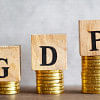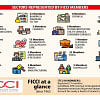ESCAP forecasts steady growth for Bangladesh
The UN has predicted a steady economic growth for Bangladesh this year and the next year, but voiced concern over rising inequality and slow rate of poverty reduction.
The UN Economic and Social Commission for Asia and the Pacific (ESCAP) projected the country's GDP growth at 6.8 percent in 2016 and 7 percent in 2017.
The prediction is based mainly on steady growth in employment, domestic consumption supported by lower inflation, higher remittances from workers and rising public sector wages, said Dr Shuvojit Banerjee, economic affairs officer of the ESCAP.
However, concern remains over rising inequality and slow rate of poverty reduction, he said at the launch of the Economic and Social Survey of Asia and the Pacific 2016 at the capital's IDB Bhaban yesterday.
Referring to the survey findings, Debapriya Bhattacharya, distinguished fellow of the Centre for Policy Dialogue, said the country's GDP growth is fine, but it may not benefit the poor.
One-third of the country's population is poor, given the daily per capita income of $1.25. But the proportion of the poor might go up to 40 percent if the new measure of daily per capita income of $1.9 is considered, he said.
ESCAP's annual report analysed the region's economic and social status and its link to the changes in the global scenario characterised by low oil prices and economic slowdown in Euro zone, China and Japan.
In a separate chapter on Bangladesh, it said garment export, which accounts for more than 80 percent of the country's total exports, was sluggish on subdued orders from Europe and lower cotton prices.
“Despite favourable workers' remittances, strong import demand and tepid export of goods pushed the current account balance into a deficit of 0.8 percent of GDP in 2015, the first shortfall in three years,” the report said.
On the downside, it said, high non-performing loans could constrain the growth of bank loans, while there are challenges of low productivity and low investment.
Debapriya said Bangladesh's export market faces challenges due to continued economic slowdown in developed countries and the refugee crisis that might lead to diversion of foreign aid.
If the downturn lingers, it would affect Bangladesh that heavily relies on exports to developed countries. Besides, countries such as Laos and Cambodia may become more competitive than Bangladesh.
“Capital outflow would be towards the US if it raises interest rates. In that case, the capital that could be invested here would be flowing to the US,” he said.
Debapriya said the authorities should put emphasis on quality education that matches the labour market demand. There is a need for increasing investments to create more jobs and raising budgetary allocations for health and education sectors.
Shuvojit observed that income inequality in Bangladesh is going up.
In Bangladesh, the poor earn less than $2 a day while the high income group earns more than $20, according to the report.
The emerging middle class is “very vulnerable to falling back into poverty due to shocks such as a persistent decline in economic growth and employment prospects, disease in the family or loss of the main breadwinner and natural calamities”, it said.
Shuvojit suggested several measures such as increasing government revenue by direct tax, higher and targeted fiscal spending, creating an environment conducive to investment and focusing on enhancing agricultural productivity.
UN Resident Coordinator Robert Watkins said the government should diversify the economy to create more jobs and take advantage of a huge number of working-age people in Bangladesh.

 For all latest news, follow The Daily Star's Google News channel.
For all latest news, follow The Daily Star's Google News channel. 







Comments